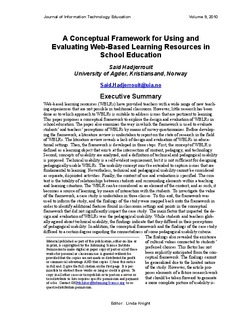A conceptual framework for using and evaluating web-based learning resources in school education
Journal article, Peer reviewed
Permanent lenke
http://hdl.handle.net/11250/138149Utgivelsesdato
2010Metadata
Vis full innførselSamlinger
Originalversjon
Hadjerrouit, S. (2010). A Conceptual Framework for Using and Evaluating Web-Based Learning Resources in School Education. Journal of Information Technology Education, 9, 53-79. https://doi.org/10.28945/1106Sammendrag
Web-based learning resources (WBLRs) have provided teachers with a wide range of new teachingexperiences that are not possible in traditional classroom. However, little research has beendone as to which approach to WBLRs is suitable to address issues that are pertinent to learning.This paper proposes a conceptual framework to explore the design and evaluation of WBLRs inschool education. The paper also examines the way in which the framework is used to evaluatestudents? and teachers? perceptions of WBLRs by means of survey questionnaires. Before developingthe framework, a literature review is undertaken to report on the state of research in the fieldof WBLRs. The literature review reveals a lack of design and evaluation of WBLRs in educationalsettings. Then, the framework is developed in three steps. First, the concept of WBLR isdefined as a learning object that exists at the intersection of content, pedagogy, and technology.Second, concepts of usability are analyzed, and a definition of technical and pedagogical usabilityis proposed. Technical usability is a self-evident requirement, but it is not sufficient for designingpedagogically usable WBLRs. The usability concept must be extended to capture issues that arefundamental to learning. Nevertheless, technical and pedagogical usability cannot be consideredas separate, disjointed activities. Finally, the context of use and evaluation is specified. The contextis the totality of relationships between students and surrounding elements within a teachingand learning situation. The WBLR can be considered as an element of the context, and as such, itbecomes a source of learning, by means of interaction with the students. To investigate the valueof the framework, a case study is undertaken in three classes. To this end, the framework wasused to inform the study, and the findings of the study were mapped back onto the framework inorder to identify additional features found in classroom settings and points in the conceptualframework that did not significantly impact the case study. The main factor that impacted the designand evaluation of WBLRs was the pedagogical usability. While students and teachers globallyagreed about technical usability, the findings indicate that they differed in their perceptionsof pedagogical usability. In addition, the conceptual framework and the findings of the case study differed to a certain degree regarding the connectedness of some pedagogical usability criteria
